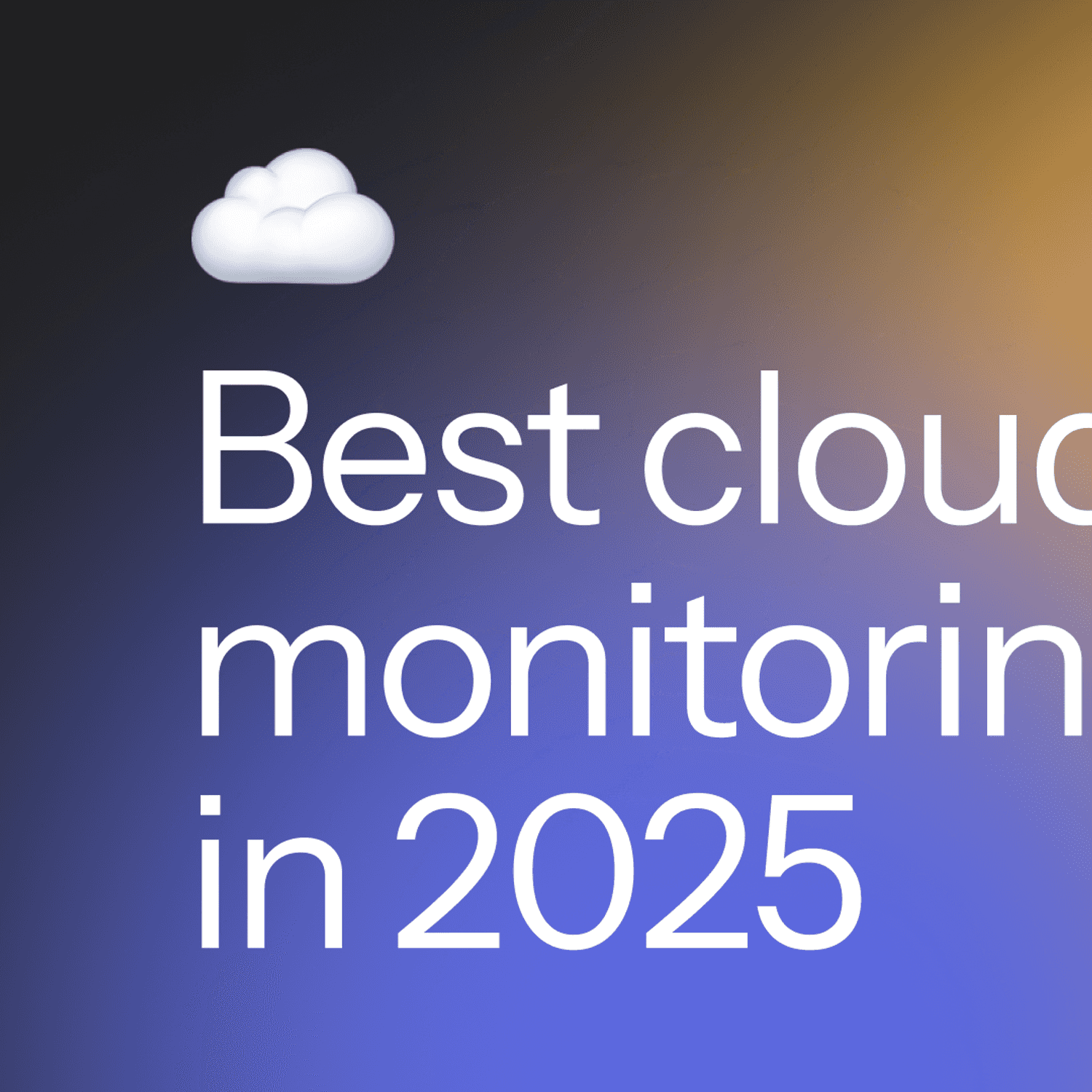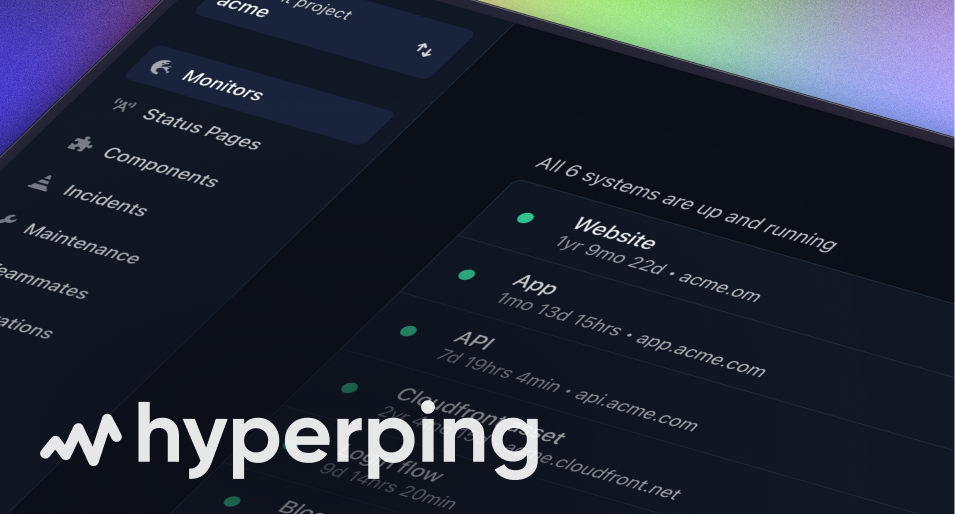Getting that message from a customer — "Your site is down!" — feels like a punch to the gut.
Manual checks and basic scripts leave too much to chance.
When every minute offline costs you money and frustrated customers, you need reliable uptime monitoring tools.
But the market offers dozens of options, which can make choosing the right one challenging.
This guide cuts straight to what works. We'll explore proven monitoring solutions, essential criteria that matter for your needs, and go through our top picks.
What are uptime monitoring tools and what are their benefits?
Uptime monitoring tools work like digital watchdogs, checking your website and servers around the clock. When something breaks, you get an alert immediately.
These tools run automatic checks on your systems, eliminating manual work and those dreaded "your site is down" emails from customers.
- Early problem detection — Get alerts before users notice issues. Teams typically cut their downtime in half by spotting and fixing problems early.
- Better customer experience — A reliable website builds trust. When issues occur, your status page keeps users informed automatically.
- Time back for your team — Automated checks free up your team to focus on what matters: product improvements, customer support, feature development.
- Clear performance insights — See exactly how your systems perform: global availability, response time, SSL certificate health, etc.
- Streamlined communication — Keep everyone in the loop with automated status page updates, incident history, maintenance schedules, and more
Basic vs advanced monitoring: what's different?
Basic monitoring only checks if your site responds. Advanced monitoring:
- Runs synthetic checks
- Tests from multiple locations
- Alerts specific team members
- Connects to your toolset
- Creates detailed reports
Let’s take an online store as an example:
- Monitoring spots a slow checkout page
- Alerts arrive before customer complaints
- Quick fixes maintain 99.9% uptime
- Status pages update automatically
Types of monitoring
Your website needs different kinds of monitoring, just like a house needs various security measures. Each type serves a specific purpose to keep your systems running smoothly.
- URL/HTTP monitoring — The simplest check: does your website respond when someone visits? This basic test confirms your site is accessible to visitors.
- Port monitoring — Checks critical connection points beyond your website - database connections, email servers, and other technical access points.
- Cron job monitoring — Confirms your scheduled tasks run correctly. Backups, updates, and maintenance happen when they should.
- Synthetic monitoring (browser checks) — Runs automated tests that click buttons, fill forms, and move through your site. This catches problems before real users do.
- SSL certificate monitoring — Watches your security certificates to prevent expiration. No more surprise security warnings for your visitors.
- Keyword monitoring — Alerts you when specific words appear or vanish from your pages. Perfect for tracking error messages or required content.
- API monitoring — Ensures smooth data flow between your site and external services. When APIs fail, features break.
- Performance monitoring — Tracks your website's speed metrics — page load times, server response, and resource loading. Slow sites frustrate users and hurt business.
- Real User Monitoring (RUM) — Collects data from actual visitors using your website. You'll see exactly how people experience your site across different devices, browsers, and locations.
Benefits of multiple monitoring types
A single monitoring type leaves gaps in your coverage. Using several types:
- Catches different kinds of problems
- Reveals issues that hide from basic checks
- Gives each team member relevant data
- Provides complete coverage for complex sites
Monitoring frequency guide
Each type needs its own schedule:
- Basic HTTP checks — Every 30 seconds to 5 minutes
- SSL monitoring — Daily
- Synthetic monitoring — Every 5-15 minutes
- Cron job monitoring — Matches your task schedule
- API monitoring — Every 1-5 minutes
8 criteria to choose the right uptime monitoring tool
Finding the right uptime monitoring tool doesn't have to be complicated. Here's what matters most when evaluating your options.
- Integrations that matter — A good monitoring tool connects seamlessly with your existing stack. When alerts flow directly into Slack, Discord, or PagerDuty, your team stays informed without switching between multiple apps.
- Not breaking the bank — Some monitoring solutions like Datadog charge premium prices, but you can find powerful alternatives at reasonable rates. Pick a tool with transparent, usage-based pricing instead of per-user costs that grow with your team.
- Comprehensive monitoring coverage — Great monitoring tools extend beyond basic port checks to include: SSL certificate tracking, cron job checks, and synthetic monitoring for proactive issue detection.
- Focused features, none of the bloat — Skip the massive application performance monitoring suites. Choose specialized tools that excel at uptime monitoring without unnecessary complexity.
- Built-in status pages — Status pages work best when they're part of your monitoring solution. Built-in status pages automatically update your customers when issues occur, saving you time and effort.
- Advanced alerting — An effective monitoring system should offer complex alerting rules and escalation policies to avoid notification fatigue.
- Fast check frequency — Quick detection requires frequent monitoring. Look for tools that check your services every minute or less to minimize downtime impact.
- Global locations — With users accessing your services worldwide, you need monitoring points across different regions to catch location-specific problems quickly.
We analyzed 28 tools, we selected 5. Here’s why.
After extensively analyzing 28 popular website monitoring services, we narrowed down our selection to just 5 top performers.
Here's a detailed breakdown of why many tools didn't meet our strict criteria for comprehensive uptime monitoring.
- Limited monitoring capabilities — Several tools didn’t have extended capabilities when it came to monitoring. That includes StatusCake, Pulsetic, Montastic among others.
- Enterprise overkill and pricing issues – Many enterprise solutions proved too complex and expensive for startup teams: Datadog, New Relic, Checkmk, and more.
- Incomplete feature set — Some tools included in other guides were not really a fit for our guide because they focused on performance monitoring and not uptime, or they didn’t have built-in status pages. Linko or Zippy are some of these tools that didn’t fit these criteria.
Top 5
Based on our criteria, here are our top picks for the best uptime monitoring tools:
- 1 Hyperping
- 2 Better Stack
- 3 Uptime
- 4 Cronitor
- 5 Uptime Robot
Yes, we are Hyperping and you could think it’s bias. This guide will show you that we have the arguments to back it up.
Is it totally unbiased? Of course not, but no other guide is.
At the end of the day, we try to make your choice the easiest it can be and at the same time give you easy to read information so that you don’t have to read 10 different guides to have all your answers.
Top 5 pricing & limits
Hyperping Pro plan costs $74/month for 100 monitors, 10 browser checks, unlimited public & private status pages, and 6 users.
Some alternatives have complex pricing, but here’s our best effort at a fair comparison.
| Total monthly price | Uptime monitors | Cron job monitors | Synthetic monitors | Advanced status pages | Users | |
|---|---|---|---|---|---|---|
| Hyperping | $74/m | 100 | ✅ | 10 | Unlimited | 6 |
| Better Stack | $199/m min. | 10 included, $21/m per 50 monitors | 10 included, $17/m per 10 monitors | $4/m for 10k runs | 1 basic included, $12/m/page + addons | $29/m/user |
| Uptime | $67/m | 50 | ✅ | 16 | 2 | 10 |
| Cronitor | $250/m min. | $2/m/monitor | $2/m/monitor | $1/m per 1k runs | 1 included, $25-50/m/page | $5/m/user |
| Uptime Robot | $29/m | 100 | ✅ | ❌ | 100 | 3 |
1. Hyperping
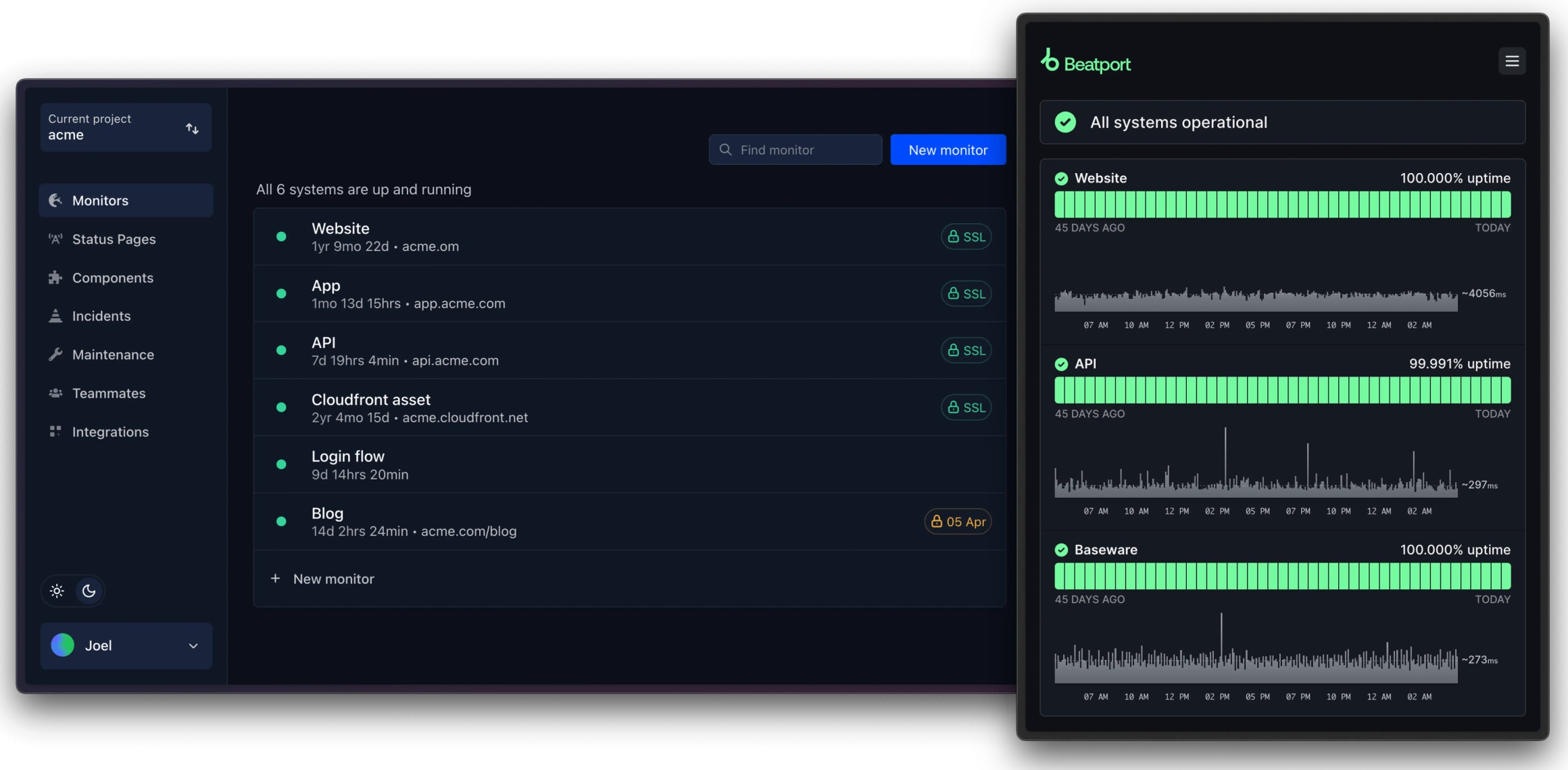
Hyperping combines comprehensive uptime monitoring with powerful status pages, designed specifically for DevOps and SRE teams in startups. Its straightforward approach focuses on what matters most: catching issues early and keeping everyone informed.
Key features
- Complete monitoring suite — URL checks, SSL monitoring, port monitoring, cron job tracking, and synthetic monitoring with Playwright.
- Fast frequency — 30-second check frequency on all paid plans with monitoring from multiple global locations.
- Advanced status pages — Public and private pages with component-level status, SSO options, and multi-tenant support.
- Response time tracking — Basic performance monitoring with response time data.
- Smart alerting — Customizable escalation policies, voice calls, and integrations with popular DevOps tools.
- EU-based infrastructure — GDPR-compliant hosting in European data centers.
Pros
- Simple, predictable pricing without per-user fees
- Quick setup with minimal configuration needed
- Code-based synthetic monitoring using Playwright
- Voice call alerts included in all plans
- Unlimited status pages on Pro & Business plans
Cons
- More basic reporting features than the competition
- Free plan a bit more limited
Bottom line
We ranked Hyperping #1 because it hits the sweet spot between functionality and simplicity. While competitors either offer too many features at premium prices or too few features at budget prices, Hyperping delivers the exact tools DevOps teams need at a fair price point.
The Pro plan at $74/month includes:
- 100 uptime monitors
- 10 synthetic monitors
- Unlimited status pages
- 5 team members (+ admin)
- All premium features
For teams that need reliable monitoring without the complexity and cost of enterprise solutions, Hyperping offers the best balance of features, usability, and value.
2. Better Stack

Better Stack delivers a comprehensive monitoring and incident management platform that combines uptime monitoring, logs, and on-call scheduling. It's built for engineering teams who need deep insights and robust incident response capabilities.
Key features
- Full-stack monitoring — URL checks, SSL monitoring, browser checks, and API monitoring with detailed reporting.
- Incident management — Built-in incident response tools with on-call scheduling and escalation.
- Advanced logging — Centralized log management with powerful search and analysis.
- Status pages — Customizable status pages with component dependencies and automation.
- Rich integrations — Deep integration with popular DevOps tools and services.
Pros
- Comprehensive feature set beyond just monitoring
- Powerful incident management capabilities
- Advanced reporting and analytics
- Strong API and integration options
- Modern, user-friendly interface
Cons
- Complex pricing structure with many add-ons
- Can get expensive quickly as you scale
- No longer EU-based (moved to US)
Bottom line
Better Stack ranks #2 because it offers more features than Hyperping but at a significantly higher price point. While Hyperping focuses on doing monitoring and status pages exceptionally well, Better Stack provides a broader toolkit that includes logging and incident management.
The pricing difference is substantial:
- Better Stack has a great free plan but everything more costs a lot: monitors are $21/month per 50, users are $29/month each, and status pages are $12/month each with many advanced options costing extra.
- Hyperping provides 100 monitors, 10 synthetic monitors, unlimited status pages, and 6 users for $74/month
Choose Better Stack if you need the full incident management suite and don't mind paying premium prices. Choose Hyperping if you want focused uptime monitoring and status pages at a more reasonable price point.
3. Uptime

Uptime offers a comprehensive website monitoring platform with a strong focus on real user monitoring (RUM) and visual synthetic testing. Their solution caters to businesses looking for detailed performance insights alongside traditional uptime monitoring.
Key features
- Visual synthetic monitoring — No-code browser checks through a visual editor for testing user flows.
- Real User Monitoring — Track actual visitor experiences and performance metrics.
- Multi-location checks — Monitor from numerous global locations (though full access requires premium plans).
- Advanced reporting — Detailed performance analytics and custom report generation.
- Status page builder — Public status pages with branding options.
Pros
- Extensive monitoring location network
- User-friendly visual editor for synthetic tests
- Comprehensive real user monitoring
- Rich performance analytics
Cons
- Premium features locked behind expensive plans
- Escalation policies need individual setup per monitor
- Visual editor limits synthetic test capabilities
Bottom line
Uptime ranks #3 for delivering solid monitoring capabilities with valuable RUM features, but its pricing structure and limitations on basic plans hold it back from higher rankings. While Hyperping offers 30-second check frequency and unlimited status pages for $74/month, Uptime requires their $285/month plan for similar check frequencies and full location access.
For teams needing real user monitoring and visual synthetic tests, Uptime provides these capabilities well.
However, teams seeking more frequent checks, code-based synthetic monitoring, and better value should consider Hyperping's straightforward pricing and feature accessibility.
4. Cronitor
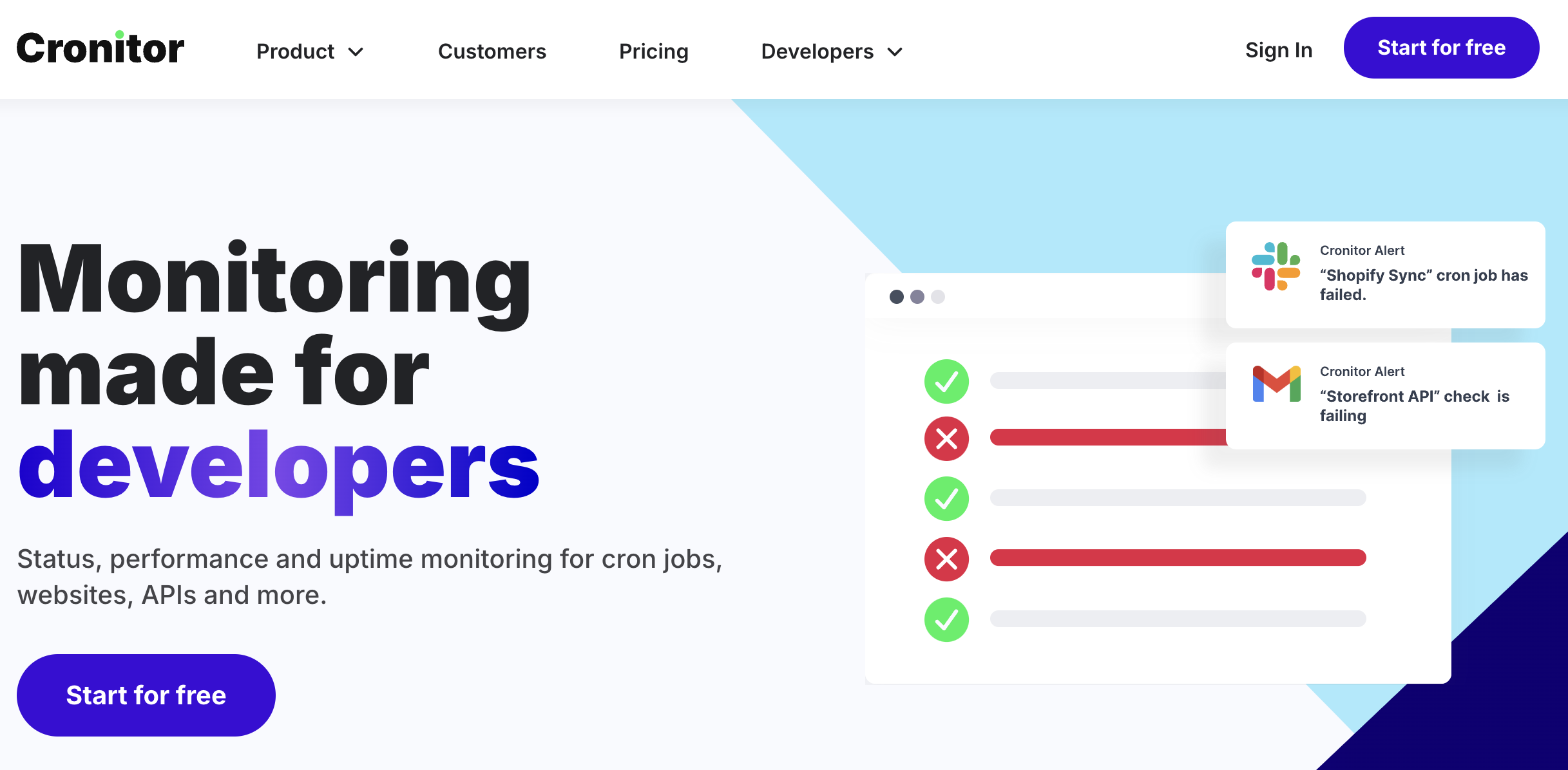
Cronitor specializes in cron job and uptime monitoring with a developer-first approach. Their platform focuses on reliability monitoring through usage-based pricing, making it particularly appealing for teams with specific monitoring needs.
Key features
- Developer-oriented monitoring — API-first platform with detailed documentation and flexible integration options.
- Comprehensive cron monitoring — Advanced scheduling options and detailed job execution tracking.
- Real User Monitoring (RUM) — Collect performance data from actual user sessions.
- Customizable reporting — Daily digests and detailed performance analytics.
Pros
- Excellent documentation and API support
- Detailed cron job monitoring capabilities
- Usage-based pricing can work well for small deployments
- Daily performance reports included
Cons
- No voice call alerts
- Limited status page functionality
- No escalation policies
- Visual editor for synthetic monitoring limits flexibility
- Usage-based pricing can become expensive quickly
Bottom line
Cronitor ranks #4 because while it excels at cron monitoring, it lacks some critical features modern DevOps teams need.
The usage-based pricing model sounds attractive but can lead to unexpectedly high costs as your monitoring needs grow.
Teams looking for predictable pricing and a complete feature set will find better value with Hyperping's straightforward plans.
5. Uptime Robot
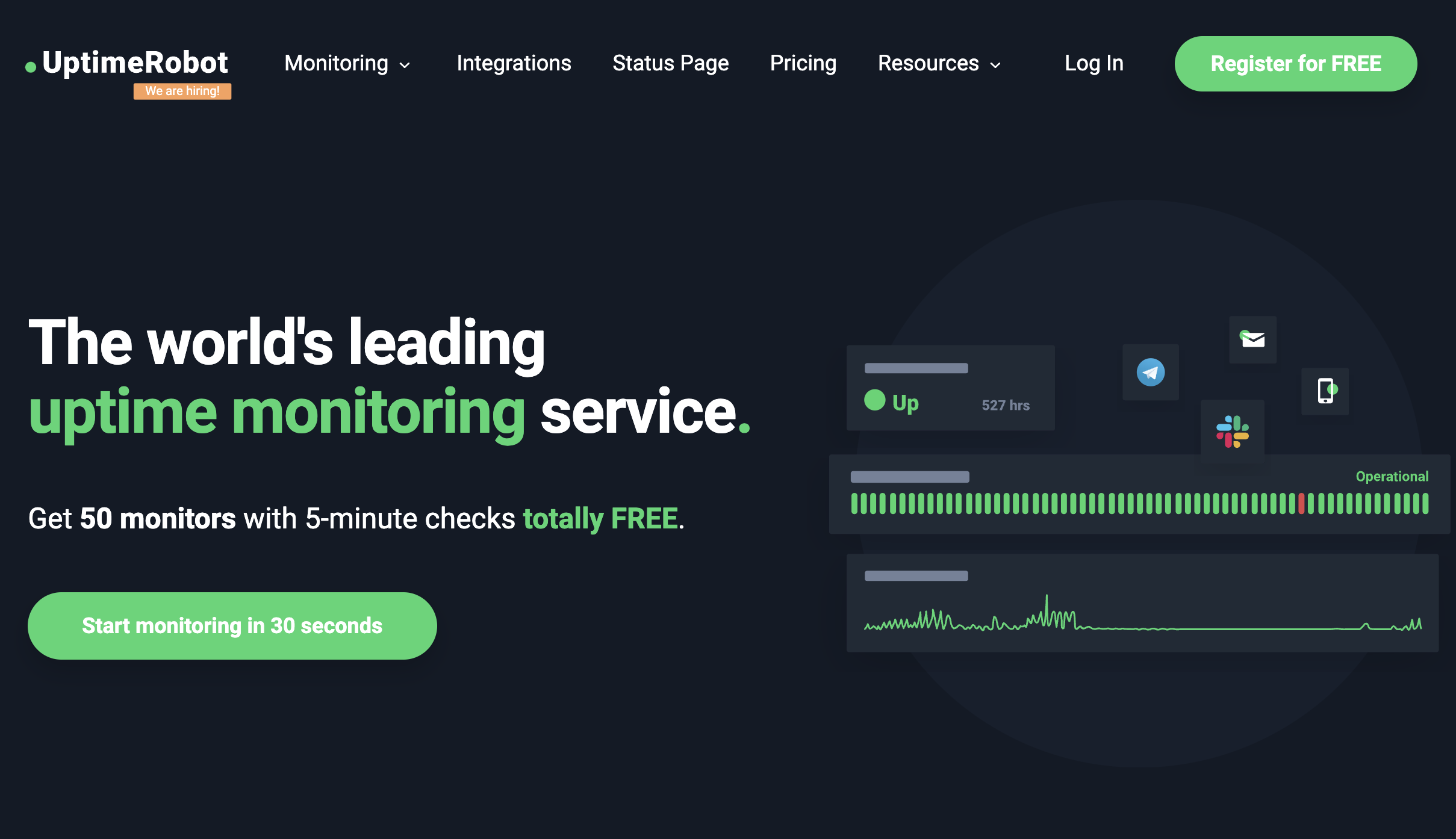
Uptime Robot offers straightforward monitoring solutions with a focus on simplicity and affordability. Popular among small businesses and developers, it provides basic monitoring capabilities with one of the most generous free plans in the market.
Key features
- Basic monitoring types — HTTP(S), ping, port, and keyword monitoring.
- Mobile apps — Native iOS and Android apps for on-the-go monitoring.
- Status pages — Basic public status pages with customization options.
- Response time tracking — Basic performance monitoring with response time graphs.
Pros
- Very competitive pricing
- Generous free plan with 50 monitors
- Simple, easy-to-use interface
- Native mobile apps
- 5-minute check intervals on free plan
Cons
- No browser checks/synthetic monitoring
- Missing escalation policies
- Limited status page features
Bottom line
We ranked Uptime Robot #5 because while it excels at basic monitoring needs, it lacks the advanced features modern DevOps teams require.
Compared to Hyperping, Uptime Robot offers a more limited toolset — particularly noticeable in its absence of synthetic monitoring and advanced status page capabilities.
While Uptime Robot costs less than Hyperping ($29/month vs $74/month), the price difference reflects significant feature gaps.
Teams needing synthetic monitoring, escalation policies, or advanced status pages should consider Hyperping's more comprehensive solution.
However, for small projects requiring only basic monitoring, Uptime Robot remains a solid, budget-friendly choice.
Conclusion
Modern uptime monitoring tools have evolved beyond simple availability checks into comprehensive platforms for system reliability.
The best solutions combine synthetic monitoring, cron job tracking, and automated status pages to help teams catch issues early and maintain strong SLAs.
Take these steps to level up your monitoring:
- 1 List your must-have monitoring needs (SSL checks, port monitoring, cron tracking)
- 2 Start a free trial of 2-3 tools that match your requirements
- 3 Set up basic monitoring for quick wins (most tools have free versions for basic features, including Hyperping)
- 4 Test alerting systems and status pages with your team
Every minute of downtime impacts your reputation and revenue.
A solid monitoring solution helps you deliver the reliability your users need while keeping your team informed and efficient.
Hyperping combines powerful monitoring with user-friendly status pages — start your free trial now and see the difference proper monitoring makes.
Which monitoring challenge will you tackle first?
Frequently asked questions about uptime monitoring tools
After reviewing the top uptime monitoring tools, you might still have some questions. Let's address the most common queries about website monitoring services and uptime tracking software.
What is the best free uptime monitoring service?
A lot of providers offer a free tier. Uptime Robot stands out with 50 free monitors but a long check frequency (5 minutes). Hyperping also offers a free plan with 5 monitors, status page, and a shorter check frequency (3 minutes).
How do I monitor my website uptime?
Monitoring your website uptime involves these key steps:
- 1 Choose an uptime monitoring tool
- 2 Add your website URL(s)
- 3 Configure check frequency (typically 1-5 minutes)
- 4 Set up notification channels (email, Slack, SMS)
- 5 Configure status pages (optional)
What is a good website uptime percentage?
Most businesses aim for 99.9% uptime (known as "three nines"), which translates to approximately 8.76 hours of downtime per year. However, many enterprise SLAs require 99.99% uptime (less than 1 hour downtime yearly).
How much does website monitoring cost?
Pricing typically ranges from:
- Free: Basic URL monitoring
- $10-50/month: Small business plans
- $50-200/month: Professional plans
- $200+/month: Enterprise solutions
Costs usually depend on:
- Number of monitors
- Check frequency
- Additional features (synthetic monitoring, status pages)
What's the difference between uptime and performance monitoring?
- Uptime monitoring — Checks if your service is responding. It's like ensuring your store's door is open.
- Performance monitoring — Measures how well your service performs. It's like tracking how quickly customers get served.
Can I monitor multiple websites with one tool?
Yes, all major uptime monitoring tools support multiple websites. Most providers offer:
- Grouped monitoring
- Separate alerting per website
- Consolidated dashboards
- Different check types per website
How often should website uptime be checked?
Recommended check frequencies:
- Critical systems: Every 1 minute
- Standard business websites: Every 5 minutes
- Non-critical systems: Every 10-15 minutes
What features should a good uptime monitoring tool have?
Essential features include:
- Multi-location monitoring
- Various check types (HTTP, SSL, TCP)
- Advanced notifications
- Status page functionality
- Historical reporting
- API access
- Integration capabilities


